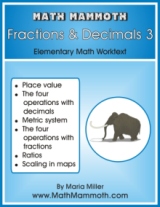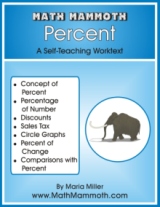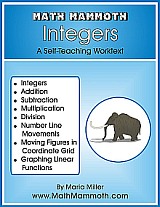I had mixed feelings when I heard that members of this year's Crew would have the opportunity to review Math Mammoth products. You see, I was on last year's Crew, and when notified that we'd be reviewing this math program, I went to the website to look and got completely overwhelmed.
This year I screwed up my courage (yes, I was still bewildered by the number and variety of math products offered... that hadn't changed) and contacted the author, Maria Miller. I gave her specifics about the girls and their progress (or lack thereof) in the math department, and asked for her advice.
She was very helpful! She's obviously familiar with math anxiety (yes, it's not just the girls, it's me, definitely me) and in our email exchange, she gently and thoughtfully discussed the various options (full curriculum vs. individual topics vs. worksheets) in terms of my children and their math needs. She left the final decision up to me. The choice ended up being between a full curriculum that said "6th grade" (which might be something of a slap in the face, considering Youngest is in 8th grade and her sisters are higher), or specific topics that are not labeled with a grade level, yet contain the same material as found in the grade-level curriculum.
Placement help
By the way, if you're as confused as I was about teaching math to math-resistant students, Math Mammoth has a great offer. From the Math Mammoth website:
Take a 7-day virtual email tour around Math Mammoth! You'll receive:
- A package of 300 free worksheets and sample pages;
- 7 individual emails on 7 subsequent days that answer the most commonly asked questions, including "What is the difference between all these different-colored series?"
We received three books: Fractions and Decimals 3 (this one does say "elementary worktext" on the front, but it's the highest level fractions/decimals workbook in the series), Percent, and Integers. I was interested to note that the latter two titles were marked as "self-teaching," a phrase to warm the heart of any homeschool mom who wants her children to work independently.
Here's a rundown on each book:
Fractions & Decimals 3 is identified as a sixth-grade book, but if you have a math-phobic child, you know that grade level doesn't really matter. Your children need a basic understanding, a foundation, an underpinning -- they need to know fundamentals before they can go on to advanced, abstract thinking. Just because my girls' friends are all doing Algebra 1, doesn't mean the girls can tackle it!
They can want to all they want (for one, it's because her friends all got through algebra -- now there's peer pressure for you -- for another, it's because she wants to be finished with schoolwork, and algebra presents an obstacle. Two of the girls understand fractions and decimals fairly well; for the third it's a stumbling block.
Fractions & Decimals 3 contains an introductory chapter aimed at the parent, discussing the material in the book and offering suggestions for teaching. For example, if this is mostly review for your student, you're encouraged to let them do half the problems, or even a third of the problems, enough to demonstrate understanding without becoming busywork. Some sections of the book are identified as material for advanced students or for those who are interested and want to do more.
One of the girls took one look at the book and announced she was beyond all that. Fine. This is the kid who seems to have an intuitive grasp of how math works, even though it was very difficult for her to memorize math facts. Drill didn't work. For the longest time, I let her use math tables as a reference when doing her math problems, and eventually the facts began to stick as she used them in problems. (It made the information relevant, I suppose.)
For another of the girls, it was all review and so she didn't need to do every problem. For the third, who always hits the wall when she studies fractions (I can't tell you how many different math programs we've tried), it's a matter of plugging along, page by page.
We're not there yet, but we're working at it.
Some of the things I like
- introductory chapter -- more hand-holding for this nervous-towards-math mom, but good advice for tackling the program with three very different learners. Also an extensive list of online math resources and games to reinforce fraction/decimal learning!
- logical layout, minimum clutter, no filler -- some math books have distracting pictures and illustrations that don't have much to do with the math being presented. Fractions & Decimals 3 is a no-nonsense text. There are charts and boxes filled with explanations and examples, of course, and a judicious use of color. I started out printing lessons in black and white, but after looking more carefully at the pages I chose, instead, to print pages in color as the color enhances the explanations. On this sample page, you can see how red arrows draw the eye in an explanation to the important information.
- straightforward explanations -- the author doesn't take it for granted that you can keep all these math terms straight as well as she can. An example of this is this phrase from the sample page mentioned above: "Our goal is always to make the divisor on the bottom into a whole number." Note that she doesn't just say divisor, something that leads to a surge of panic in the brain, causing the student to freeze momentarily, thinking, "What is the divisor? I can't remember what a divisor is/does. Now I have to go back and look it up again. Aargh." No, she says, divisor on the bottom. It might seem like a minor thing to you, but to people (like me and mine) with math anxiety, it's big. It's a sign of innate courtesy on the author's part, it's something that she didn't have to include, but did, and it's part of what makes this program work for us.
- periodic review
- answer key included
- copy permission -- I can buy one book and use it with all three girls, printing out just the pages each one needs.
- bargain price -- This 128-page book is available as a PDF download for $7, or printed in black and white for $12.70. Click on the link to go to the order page, to read more about the book, and to get access to free sample pages. Frankly, I'm glad we got the PDF download. While color ink is expensive, I'm finding the colors very helpful for one of the girls. For the others, where the color doesn't seem to make as much difference, I can print in black and white.
Percent is a "self-learning worktext" for grades 6-8. At this link you can read more about topics covered, see Youtube videos based on lessons in the book, download sample pages, and order this 65-page book. A PDF download is $3.50 (full-color), while a printed copy (black and white) is $10.60.
Percent builds on the student's previous knowledge of fractions and decimals, so if you're just jumping in, you might want to cover Fractions & Decimals 3 first as a review. Percent is just a specialized fraction, after all, a measurement in terms of hundredths. As with Fractions & Decimals 3, an introductory chapter discusses the progression of topics covered in the book and includes a list of online resources and math games.
It seemed as if there was a lot more use of color in this book, which I thought might be distracting to my oh-so-distractible learners, so I chose to save the colored ink and have printed out most of the pages we've used so far in black and white. The color images add interest, but we have a real problem with visual clutter and being easily distracted.
The text is laid out so that a student may work independently, reading through the explanations and working the problems. (I still need to sit with one of the girls, who really struggles, so I can set her straight when I see she's not understanding something quite right.) The answer key is included in the back of the book, so if you have a truly independent student, self-correction is possible, or you can keep these pages yourself and keep your hand in (and an idea of how your student is doing) by correcting your student's work yourself. (I suppose you could also have your students correct each others' work, but I haven't gone that route.)
Integers is another self-teaching worktext, aimed at students in Grades 5-8. As with Percents, the text is addressed to the student, allowing for independent work.
This 77-page worktext is available as a PDF download for $3.75, or printed in black and white for $8.75 at this link. Also at the link, you'll find a brief explanation of topics covered and links to sample pages.
Once again, I found myself printing a number of pages (not all) from this book in color, as color is used in a way that enhances the explanations, so I'm glad to have the PDF file in color (which lets me choose which pages to print in color, and which to print in black and white), rather than the black-and-white printed copy. Presentation is straightforward, review is built in, and puzzles and practical examples are included.
The Math Mammoth website includes a lot of helpful material, including free sample worksheets, placement advice, and a full listing of the curriculum. Pricing is very reasonable, and now that I've figured out where the girls need additional learning, I'm very glad for the wide assortment of products available! Instead of plowing through an entire math book, speeding through some topics and wishing there were more material in other topics, we can pick and choose and focus in our endeavor to nail down the foundational material the girls need before they can go on to advanced topics.
Read more TOS Crew reviews of product at this link.
Disclaimer: Our family received PDF copies of Fractions & Decimals 3, Integers, and Percents for review purposes. No additional compensation was involved.




No comments:
Post a Comment